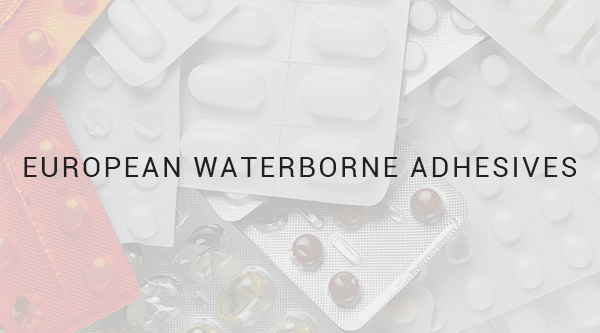Industry News, Adhesives & Sealants & Tackifiers
Market Reports: European Waterborne Adhesives, Active and Intelligent Packaging, Construction Chemicals

Industry News, Adhesives & Sealants & Tackifiers

Link: Market Reports: European Waterborne Adhesives, Active and Intelligent Packaging, Construction Chemicals | ASI
By: Adhesives & Sealants
The waterborne adhesives market in Europe was estimated at $3.26 billion in 2014 and is projected to grow at a compound annual growth rate (CAGR) of 5.8%, according to “Europe Waterborne Adhesives Market Segmented by Product Type, By Polymer, By Application, By End User Industry, and Geography Trends and Forecasts (2015-2020)” during the forecast period. Due to their eco-friendly and low-toxic nature, high solid content, and high initial adhesion properties, waterborne adhesives are becoming an integral part of various commercial and industrial sectors. The market is driven by a number of factors, such as the stringent environmental regulations to control volatile organic compound (VOC) emissions, growing automotive industry, and accelerating demand from packaging industry.
The market faces certain drawbacks, however, such as formulation constraints, and nearly matured market conditions. These factors may act as a roadblock to the growth of the market.
In addition, the market has also been geographically segmented into the UK, Germany, France, Spain, Italy, and the rest of Europe.The U.S. led the market in terms of consumption in 2014, followed by Canada and Mexico. The improvement in the financial status and purchasing power of the middle class consumers in the Asia-Pacific is accelerating the demand for automobiles and buildings in the region, making the region an area of immense potential and opportunities. As a result, most of the large-scale adhesive manufacturers in Europe have started focusing on developing strategies to penetrate the aforementioned region. However, the dearth of stringent norms regarding VOC emission from paints, coatings, and adhesives in the developing countries in the region have considerably hindered the growth potential for European waterborne adhesive manufacturers. For more information, visit www.researchandmarkets.com.
Demand for active and intelligent packaging in the U.S. is forecast to expand 7.3% annually to $4 billion in 2019, well above the packaging industry average, according to a report from The Freedonia Group. Active packaging provides functions beyond product protection and identification, such as moisture control; intelligent packaging incorporates features that indicate status or communicate product changes and other information. While many active and intelligent packaging products, such as packaged desiccants and volatile corrosion inhibitors, have a well-established presence, emerging products include antimicrobial packaging, advanced time-temperature monitors, and smartphone-enabled interactive packaging products.
Intelligent packaging demand will see the faster growth, advancing at a double-digit rate as products such as time-temperature indicators and smart labels and tags become more common. According to analyst Katie Wieser, “Although many of these products have been seen as unnecessary or cost prohibitive in the past, the development of technology that allows for low-cost production of printed electronics and the elimination of specialized electronic readers in favor of smartphones will allow them to enter the mainstream.”
Rapid adoption of tracking-enabled or interactive packaging components will be driven by recent legislation in the pharmaceutical and food markets, which requires producers to take steps to make products safer and easier to recall.
Active packaging demand is forecast to grow 5.4% per year to $2.5 billion in 2019. Demand will be driven by growth in gas scavenger products that are benefiting from the development of more advanced technology and the growing preference for foods with fewer additives. Growth in demand for corrosion control packaging, desiccants, and microwave susceptors will register more moderate gains due to market maturity. However, healthy gains will still be observed as products are introduced to perform these standard functions more efficiently. For example, new environmentally friendly corrosion control scavengers have been developed, and desiccants are now being embedded in bottles or caps to provide moisture control for pharmaceuticals. For more information, visit www.freedoniagroup.com.
The construction chemicals market in the Gulf Cooperation Council (GCC) region is projected to grow at a CAGR of over 7% during 2016 to 2021, according to the recent TechSci Research report entitled “GCC Construction Chemicals Market By Type, By End User, Competition Forecast and Opportunities, 2011-2021.” Concrete admixtures and waterproofing chemicals are the most widely consumed construction chemicals in the region, due to growing use of these chemicals in residential and commercial structures. Demand for protective coatings, as well as adhesives and sealants, is also growing in the region. Other major construction chemicals consumed in the GCC countries include flooring chemicals, grouts, mortars, and anti-corrosive agents.
In 2015, Saudi Arabia accounted for the largest share of the GCC construction chemicals market, due to large investments in infrastructure activities, as well as lucrative schemes offered by the government to attract FDI in the construction sector.
“Increasing need for economic diversification for lowering oil dependence has been resulting in rising investments toward construction activities in the GCC region,” said Karan Chechi, research director. “Additionally, huge infrastructure and industrial projects with upcoming mega events such as 2022 FIFA World Cup in Qatar and the World Expo 2020 in Dubai are projected to drive demand for construction chemicals in GCC countries in the coming years. Moreover, various government initiatives for construction of green buildings aimed at improving energy efficiency, reducing pollution, increasing water savings, enhancing indoor air quality, and decreasing operation costs, are leading to higher penetration of sustainable and green construction chemicals, thereby fueling growth in GCC construction chemicals market.”
Copyright of this article by Adhesives & Sealants. We are sharing and promoting the market innovation.
If you like this article, kindly to visit www.adhesivesmag.com